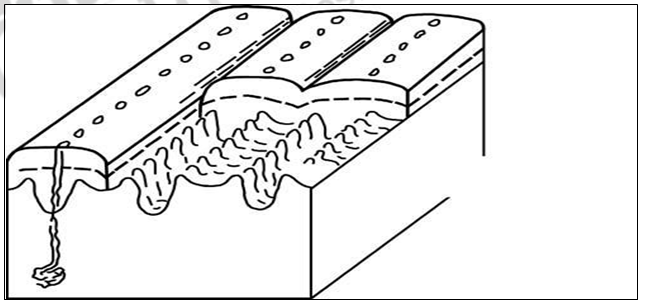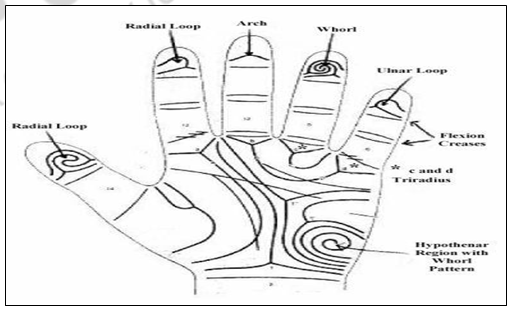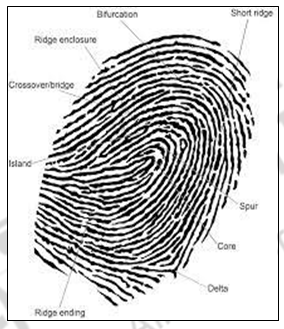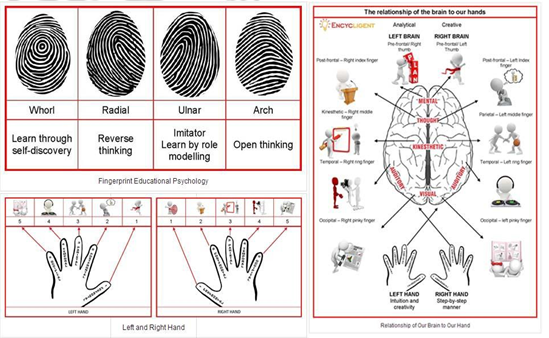15 Dermatoglyphics in Forensic Anthropology
15.1 Preface
Dermatoglyphics was first applied in the pathological studies, later got extended to study violent criminals in the FBI. Because finger prints are genetic, one can identify the personality and potential of a person based on his/her 10 finger prints. Since each person fingerprints is unique, fingerprints are also used for personal identification purposes. And parents can also understand their children innate character and learning potential. Dermatoglyphic traits are formed under genetic control early in development but may be affected by environmental factors during first trimester of pregnancy. These patterns may represent the genetic makeup of an individual and therefore his/her predisposition to certain diseases also. Dermatoglyphics has been studied in certain clinical disorders which are associated with chromosomal and developmental defects like mongolism, Turner’s syndrome, cardiovascular disease,
Diabetes mellitus, schizophrenia and ischemic heart disease. Epidermal ridge patterns of finger tips were studied to find out dermatoglyphics features in patients of such diseases and their correlation with normal population. But in this module, we shall only be focussing on the forensic aspect of dermatoglyphics.
15.2 Learning Outcome
In this module, we shall be focusing on the importance of most important evidence in personal identification i.e; dermatoglyphics. The students will learn basics of dermatoglyphics in forensic anthropological set up. Dermatoglyphics has direct interest and application to anthropology and continues to grow since the turn of the century. Anthropological dermatoglyphics can offer important perspectives in viewing the nature and significance of human variation. Several forefronts of ongoing research are reviewed. First, methodology continues to improve definition and classification of variables. A second line of inquiry deals with hereditary aspects. Inheritance models, both monogenic and polygenic, have been proposed. Single locus systems seem to have limited application, as in the transmission of triradial excess or deficiency illustrated by the missing c triradius. Polygenic inheritance has been demonstrated in quantitative phenotypic expressions exemplified by the total finger ridge-count. Maternal and other environmental effects have been shown to operate on dermatoglyphic expression.
15.3 Introduction
The word dermatoglyphics comes from two Greek words (derma, skin and glyphe, carve) and refers to the friction ridge formations which appear on the palms of the hands and soles of the feet. Dermatoglyphics is the scientific study of fingerprints. The term was coined by Dr. Harold Cummins, the father of American fingerprint analysis, even though the process of fingerprint identification had already been used for several hundred years. All primates have ridged patterns on their palmar and plantar surfaces for better and easy grip. Our fingers and feet have the most stripes (lines). Human population studies using dermatoglyphics began with early racial descriptions and currently utilize multivariate procedures for detecting evolutionary processes. Congruence testing between dermatoglyphics and other biological distance measures is also an active endeavour. In this connection, dermatoglyphics variable selection has become important in recognizing that different variables might well be useful in micro- and macro- evolutionary situations. The human dermatoglyphics traits present variations within and between populations and could be used for estimating the genetic distances between populations. Dermatoglyphics attracted a great number of scientists from all sections of biology, medicine and biological anthropology and links between dermatoglyphics and diseases or congenital abnormalities have also been explored. In fact, Dermatoglyphs are used as easily accessible tool to assess genetically determined diseases. Moreover, dermatoglyphics have been used extensively to characterize human populations and most studies have focused on dermatoglyphics variables within and between various populations across the world or between sexes. In the latter and in more recent studies, the dermatoglyphics traits are used for estimating the genetic distances between populations.
The skin is the largest sensory organ of the body. The skin is sensitive to many kinds of ‘stimuli’ such as, pressure and temperature. Within the skin, there are different types of ‘receptors’ that are activated by different stimuli. The finger is the receptor. It contains sensory neurons. When the receptor is activated, it triggers a series of nerve impulses. For a person to ‘feel’ the stimulus, the nerves impulses must make their way upto brain. Nerves control specific muscles and provide sensation to the body. The median nerve carries sensory messages from the thumb and some fingers to the brain, and also instructions from the brain to the muscles in the hand.
Also, dermatoglyphic analysis has been applied to primate studies. Although this area has not kept pace with human studies, primate work has been crucial for the important matters of taxonomic assessment and functional dermatoglyphics.
Fingerprints or Dermatoglyphs consist of patterns formed by parallel ridges on bare skin of fingertips. They are typical for higher primates, but occur sporadically in other mammals. The dermatoglyphic patterns of dermal ridges that constitute human fingerprint are formed during early intrauterine life, between the 7th and 21st week of gestation and are fully formed at about seven months of foetus development. It is unique and it will not change throughout the life of an individual.
It has been reported that ridges are influenced by blood vessel-nerve pairs at the border between the dermis and epidermis during prenatal development. Factors such as inadequate oxygen supply, unusual distribution of sweat glands and alterations of epithelial growths could influence ridge patterns. The finger ridge configurations do not change throughout the life of individuals by environment or age factors except in events such as bruises and cuts of the fingertips. This property makes fingerprints a very attractive biometric identifier. Finger ridge counts and frequencies of all palm patterns follow the genetic modes of major genes. The distribution of interdigital patterns has been proven to follow a multi-allelic major gene mode of inheritance. However, no Mendelian modes of inheritance have been discovered for most Dermatoglyphs characteristics in pedigree studies because of either low inheritance or a too large number of contributing genes.
Figure 1 shows the history of dermatoglyphics.
Figure 1: Diagram of the final dermal surface, illustrating the dermal papillae and the corresponding mirror-image epidermal development. (Reproduced from Okajima, M. [1975b], Technical aspects of dermatoglyphic examination in primates, in Contemporary Primatology: Proceedings of the Fifth International Congress of Primatologist, S. Kondo, M. Kawai, andA. Ehara, Eds., New York: S. Karger, pp. 49–53. With permission.)
In short, we may say that Dermatoglyphics refers to the formation of naturally occurring ridges on certain body parts namely palms, fingers, soles and toes as a consequence of continuous friction which occurs in these areas. These are areas where hair usually doesn’t grow and this area enhances contact while preventing slippage. Most dermatoglyphics are correlated with genetic abnormalities and are useful in biomedical studies. They are used in the diagnosis of congenital malformations. The uniqueness of a person’s finger prints led to the analyses of one’s potential, personality and preferences by analyzing dermatoglyphics. The uniqueness is because of the reason that Dermatoglyphics is the reflection of DNA and hence does not change. Finger prints of both hands are not the same and they don’t increase in size except in cases of serious injuries. Finger prints persists lifelong unless when there is damage to dermis. During development various creases develop on the brain and are reflected on the fingerprints representing the various regions of brain. This review article deals with dermatoglyphics studies mainly based on ridge patterns of palms and fingers and the pathologies related to it.
15.4 Recording dermatoglyphics
Dermatoglyphics recording is important and prerequisite before we start analysis and deduce inferences. It is done using simple black ink. The ink is daubed on the clean glass plate and spread uniformly using a roller. The excessive ink (if any) is wiped by simply putting a white filter paper on the slab and gently pressing it. Alternatively, another method of inking is to apply the same ink onto the hands and feet of the subject and asking them to stamp it on plane white paper.
The procedure includes collecting fingerprints, palm prints and foot prints. The process takes a detailed collection of all 10 fingers of hands ad feet with due care while collecting of prints not getting smudged or overlapping. The recording involves following steps:
- Apply ink on the palms and soles of the feet stamp on paper.
- Scan prints into a computer to analyze the patterns on the prints.
- Statistical analysis of the prints in order to understand genetic sequence.
For atd angle measurement, entire palm was inked including wrist creases and hypothermal border. Sheet of paper was placed on foam rubber pad on a flat stable surface. Pressure was applied to the back of hand to fill the concavity of palm otherwise black areas will appear in the centre of palm. Wrist of the person was placed on the bottom of paper and then the rest of the palm was pressed on the paper. Back of the hand was pressed down firmly for printing the centre. These palm prints were carefully observed for atd angle. The atd angle formed between lines drawn from the triradii at the base of index and little finger to the axial triradius was measured. Axial triradius was designated as t and‘t’ or “t”.
Figure 2
Figure 3: Palm print and atd angle (t and t’‘)
The value of the angle of less than 45o corresponding of the axial triradius was designated as t, values intermediate to 45o and 56o as ‘t’ and values above 56o as t”.
Figure 4 Shows How To Measure The ‘Atd’ Angle.
[Note: The AtD-angle is e.g. known for it’s significance in Down syndrome: most people who have Down syndrome have an AtD angle > 57o (80%), while in healthy people this characteristic is far less common (7%). But quite a few other trisomy syndromes are featured.
While the AtD-angle is included in the Dermatoglyphic Multiple Intelligence Test (DMIT), the mentioned studies clearly indicate that in isolation the AtD-angle can not be used as a reliable marker for IQ – simply because the AtD-angle highly varies among the individuals of various IQ populations.
• The Atd-angle in Down syndrome
• Low Atd angle & autism
• High Atd-angle & the trisomy syndromes]
Skin ridges form distinctive recognizable patterns on the skin of the palm just as they do on the skin of the fingers, soles and toes. When three ridge systems converge on a point on the palm, the configuration is termed a triradius. Triradii are observed on five areas of the human palm, the four distal triradii being classified according to the position of the exit of their proximal radiants from the edge of the palm. The fifth area exhibits a triradius that varies in its position from a site very close to the axial border of the palm, to a site near the centre of the palm. Cummins and Midlo suggested that the axial triradius be designated t’ when it is situated close to the proximal border of the palm, t’’ when it is situated near the center of the palm, and t in its intermediate positions. The axial triradius was thus designated t or t’ or t’’depending on its proximity to the lower margin of the palm, or 0 if it is absent altogether, or ? if its presence is questionable. This system leaves a lot to be desored and has long been considered unsatisfactory, since the evaluation of this triradius depends entirely on the individual investigator’s choice as to exactly at which level should a triradius be considered t, or t’, or t”. Of all the features of the palm the evaluation of this triradius is most liable to personal error, and to be differently attributed to various categories by different investigators and hence the least likely to give satisfactorily accurate series of data for comparison of world-wide samples.
Forensic analysis involves assessing a print to determine if it can be used for a comparison. If the print is not suitable for comparison because of inadequate quality or quantity of features, the examination ends and the print is reported as not suitable. If the print is suitable, the analysis indicates the features to be used in the comparison and their tolerances (the amount of variation that will be accepted). The analysis may also uncover physical features such as recurves, deltas, creases and scars that help indicate where to begin the comparison.
The expert needs to look for the respective placing of these ridge characteristics on both crime scene as well as suspect’s fingerprints for matching. This of course is done once, the patterns analysed to be same like both prints showing whorl patterns or arch or loop etc.
Experts who study dermatoglyphics believe that fingerprints (Dermatoglyphs) were marks of embryonic nerves, which may reflect one’s genetic potential. If we understand our own qualities and nurture according, it will tremendously help in terms of career development, managing emotions, increase concentration, and improve interpersonal skills. Dermatoglyphics is like a map that leads one to understand his own potential and talents. Everyone inherits innate intelligence from their parents. And their genetic parents have the innate intelligence from their parents. If one’s intelligence gets no opportunity to be inspired and further developed, there is no way for one to develop a full range of intelligence of memory, understanding, reasoning, analysis, integration, and application.
Figure 5: Ridge characters which distinguish one’s fingerprints from another.
15.5 Analysis and uses
Dermatoglyphics is the analysis of fingerprints, palm prints and foot prints. Everyone has his/her unique prints, therefore, it can be used in criminal forensic analysis to proof identity. Dermatoglyphics evidence left behind by a suspect or victim may identify who was at a crime scene and what he or she touched. However, it is important for defense attorneys to know, and to inform the jury, that the techniques used to locate and identify fingerprints are far from a perfect science. An understanding of how fingerprints are located and lifted can help attorneys recognize if a flawed analysis was performed by investigators or lab technicians. Further, knowledge of the various fingerprint collection techniques is essential to successful cross- examination of crime scene technicians and fingerprint examiners. Locating a fingerprint often requires a vigilant and calculated search.
Many scientists believe that dermatoglyphics is the DNA genes in the human body that reflected in appearance. Although everyone has different prints, but certain patterns can be found in our prints. The distribution of prints is considered to represent brain cells’ proportion and distribution in each of the brain lobes.
Human prints can be categorized as one of the three main types which are whorls-shaped, arch- shaped, and loop-shaped. It is subdivided into eleven basic types, from which many types of analysis have been derived i.e., arch into plain arch and tented arch; whorl into true whorl and central pocket whorl; loops into radial and ulnar loops, twinned double loop or lateral pocket double loop and accidental patterns.
Figure 6: Describes the three important pattern types predominantly found.
Dermatoglyphics analysis is an integration of brain science, medicine, genetics, psychology and behavioral science. Through nearly five centuries of observation and study of genetic medicine, amount and distribution of neurons is reflected in regular patterns on our fingerprints. According to European and American experts, they found that fingerprints show different kinds of characteristics, even with monozygotic (identical) twins, their fingerprints are different. At the same time, the same fingerprints will appear again after healing of wound, as long as the injury has not affect the cells. Medical experts, with observation, recording, comparison, induction and other methods, and clinical experiences, confirmed that fingerprints provide accurate analysis of a person’s multiple intelligences and potential.
Dermatoglyphics Analysis is based on the formation and the amount of ridges on the fingerprints; dermatoglyphics analysis tells us one’s style of learning and thinking. Everyone has his/her unique fingerprints; the brain pattern grows simultaneously with the fingerprints. Each finger represents different abilities, and each pattern has its own definition. Statistics show that the accuracy rate of dermatoglyphics analysis can be up to 85%.
By analyzing Dermatoglyphs, we can accurately understand the distribution and amount of cells in the left and right brain of the cell, and predict where the potential lies. Although everyone is bored with strengths and weaknesses; if they are identified early, we may further develop the strengths and improve our weakness, so that the left and right brain may grow in a more balanced and blend way. Dermatoglyphics analysis may help:
1. In terms of personal growth
- Strengthen interpersonal communication and interaction skills
- Improve relations between the sexes
- Enhance EQ and value of life and happiness
2. In terms of education
- Multiple intelligence assessment for children
- Parent-child communication and education
- Target at talents
- Personalized education
- Define the most appropriate way of teaching and learning
3. For enterprises
- Recruitment
- Assessment of job competency and execution style
- Plan education and training
- Explore the potential of employee
- Leadership
- Interpersonal communication and interaction
Figure 7 Depicts The Relationship Of The Brain To The Hands.
Summary
In this module students have learnt about the various dermatoglyphics pattern studies. These patterns are unique and are heavily linked with one’s genetic composition and are closely related to our nervous system. In the other words, Dermatoglyphics can reveal our intrinsic qualities and talents. The ridge formations of the skin of an individual appear during the third & fourth month of fetal development. Fingerprints remain unchanged during a lifetime of an individual. The current state of medical dermatoglyphics is such that the diagnosis of some illness can now be done on the basis of dermatoglyphics analysis alone and currently, several dermatoglyphics researchers claim a very high degree of accuracy in their prognostic ability from the hand’s features. Dermatoglyphics are still useful for the evaluation of children with suspected genetic disorders and diseases with long latency, slow progression etc.
Here, we learnt forensic science is based on the fundamental principle of comparison and individualisation. And fingerprints are the most important of all evidences that need to be searched for at a crime scene, evaluated and compared with suspect’s prints. The dermatoglyphics in forensic anthropology not only deals with the basic pattern types and ridge counts to nab criminals or convicts but also deals with an integration of brain science, medicine, genetics, psychology and behavioral science.
| you can view video on Dermatoglyphics in Forensic Anthropology |








